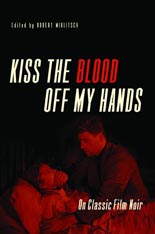
 Provocatively and perfectly titled, Kiss the Blood Off My Hands: On Classic Film Noir attempts to be, as editor Robert Miklitsch writes, “a collection that confines itself to the extraordinary scope and depth, the embarrassment of riches” of the genre. Now that film noir has bled over into, of all things, mainstream video games, perhaps it’s time for another where-we’ve-been / where-it-stands examination of this influential and invigorating type of Hollywood crime picture.
Provocatively and perfectly titled, Kiss the Blood Off My Hands: On Classic Film Noir attempts to be, as editor Robert Miklitsch writes, “a collection that confines itself to the extraordinary scope and depth, the embarrassment of riches” of the genre. Now that film noir has bled over into, of all things, mainstream video games, perhaps it’s time for another where-we’ve-been / where-it-stands examination of this influential and invigorating type of Hollywood crime picture.
The University of Illinois Press paperback concludes with a four-page appendix of “Critical Literature” on the subject, and Kiss the Blood succeeds so well in meeting its stated goal, it deserves a spot on its own list.
While the text is academic in approach, it is hardly inaccessible to any self-taught cineaste, to any criminally minded movie watcher able to see something — anything — lurking beyond the bang-bang visual surface. From as many contributors, the 10 essays within admirably convey that preface-referenced “scope and depth.” Where else can one absorb quality criticism on the use of rear projection in Edgar G. Ulmer’s now-landmark Detour?
Amid selections devoted to heist films and notable producers, Miklitsch himself attempts to answer the age-old question of “What is noir?” by pinpointing the alpha and omega — that is, the beginning and end — of America’s so-called classic cycle. In doing so, he considers the work of Orson Welles and the two Roberts (Aldrich and Wise), not to mention Supreme Court Justice Potter Stewart’s famous definition of pornography.
The book begins with a pair of female-centric pieces, as Philippa Gates and Julie Grossman respectively examine women’s roles in screen detection and film noir overall. One supposes Krin Gabbard’s chapter immediately following, on the love song’s gradual but palpable vanishing act from noir, also will hold large appeal to women readers before Kiss the Blood’s focus shifts away from gender politics and into noir’s subgenres or elements thereof.
Of particular interest is the most unusual, as J.P. Telotte explores how cartoons and animated features, from Donald Duck to Roger Rabbit, filtered, mirrored, distilled, stole and just plain parodied film noir tropes, in “Disney Noir: ‘Just Drawn That Way.’” Its specificity in subject is reflective of this collection’s major strength: variety, with credibility closely tied. —Rod Lott
